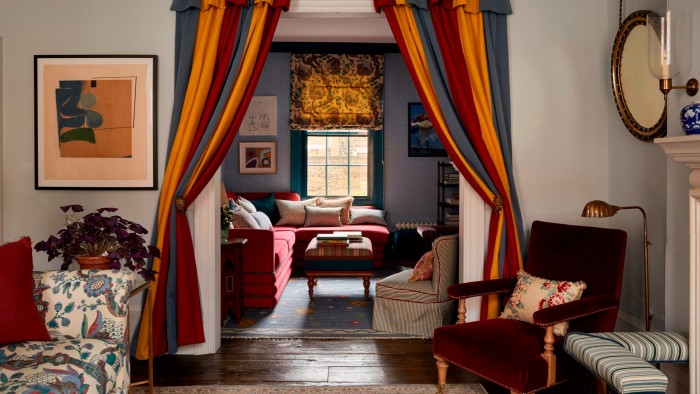Unlock the Editor’s Digest for free
Roula Khalaf, Editor of the FT, selects her favourite stories in this weekly newsletter.
When she was a child, interior designer Octavia Dickinson would clamber into her parents’ four-poster bed and draw the curtains. There, cocooned by layers of muslin, she learnt how drapery can transform the atmosphere of a space: diffusing the light, softening corners and evoking “an indulgent, all-enveloping feel”.
Curtains have been a staple of interiors since the 1500s. Now, though, they’re having a moment in the spotlight as designers look beyond window dressing to deploy fabric drapery for theatrical and practical effect on wardrobes and around book nooks, under counters and over doors. Their references are broad: tented boudoirs, swaggering Victorian room dividers, Arts and Crafts portières, and the demure, under-shelf ruffles of an Edwardian scullery are some of the influences shaping today’s curtain renaissance.
For London-based designer Tiffany Duggan, it is all about the vista. She compares the curtain to an architectural device; a draped doorway is like a “beautiful arch” tempting your gaze from one room to the next, says Duggan, who began her career as a scenic painter for plays at London’s New End Theatre and Trafalgar Studios. “Fabric adds a sense of intrigue — and mystery,” she says.

Spanish designer Marta de la Rica agrees: “it conjures a mood.” For her own home in Biarritz, she looked to the famous “Tent Room” at the 19th-century Charlottenhof Palace, Potsdam. In a top-floor bedroom, checked curtains flutter across wardrobes and a pair of whimsical tents conceals more storage, the “cocooning vibe” a foil to the vaulted, beamed ceiling.
The return of the curtain mirrors the shift to tactile, textured interiors. But perhaps there is more to it. In fractious times, a fabric-lined retreat has added appeal. It is the grown-up equivalent of a childhood den. Fabric designer Tori Murphy recalls her grandparents’ drape-strewn home in Ireland. “The curtains were an authentic solution to everyday life, used to keep in the heat from fires,” she says. But they also brought a sense of “envelopment”, turning ordinary rooms into “something theatrical — and exciting”.
But there is an argument for restraint. Designer Benedict Foley is not a fan of the “curtains everywhere” approach, especially within splashing distance of saucepans. (The tented cat’s retreat complete with scratching post, which I spotted online, is equally debatable.)


Interior designer Tom Morris offers another perspective: “Curtains are a structurally non-committal way of doing something different.” In a Victorian London terrace, he hung curtains in bold, contrasting colours to separate the bedroom from the dressing room and bathroom. They can be opened to flaunt 19th-century proportions or closed for privacy. “It was about bringing in a sense of theatrics that didn’t intrude on the architecture,” he says.
This versatility stretches to materials. Morris advocates “bog-standard” oilcloth. Duggan draped a cottage door in an embroidered Suzani. Dickinson’s Harlequinesque room divider is made using strips of plain fabric. And on the landing space of a north London cottage Foley indulged theatrical leanings with a “glazed cotton tricked into billowing folds” to resemble “a Venetian marble baldachin” canopy, but also to summon up a feeling of “Marlene Dietrich coming on stage”.


Textile designer Lucy Bathurst is similarly resourceful. Her custom-sewn panels, embellished with appliquéd motifs on linens or floor-swishing voiles, blur the line between “useful” upholstery and textile art. At her London studio she encourages clients to rifle through a “sweet shop” of remnants — milliner’s velvets, scraps of silk, lace and tweed.
No two designs are alike. One featured the client’s star signs scattered among modernist shapes; a reference to the art of Ben Nicholson, whose work Bathurst grew to love through her art-dealer father. For another, to disguise a utility room, a panel of black wool used in theatres was studded with slivers of translucent fabrics to scatter light like stained glass.
At historic interior decorating firm Sibyl Colefax & John Fowler, the late co-founder John Fowler would study historical costumes for ideas, smuggling details, such as the slash of silk in a doublet or a ruched shepherdess’s skirt, into upholstery. That tradition of imaginative borrowing continues. Managing director Emma Burns has turned antique crewelwork into a portière for a wood-panelled new-build in rural Wisconsin, inspired by an embroidered hanging at William Morris’s Kelmscott Manor.

For Burns, curtains provide solutions to awkward spaces. She cites a compact London bedroom that she wrapped in jauntily-striped drapery to conceal storage. Gilded paintings hang from chains in a nod to the splendour of Napoleon’s campaign tent, which sparked the craze for fabric-wrapped rooms.
In the one-bedroom London apartment Benedict Foley shares with fellow designer Daniel Slowik, linen curtaining divides the sitting room from the bedroom. Pulled back, the tailored folds frame the space like a pair of “fluted columns”. When closed, they provide “welcome comfort, like being in a curtained tester bed”, he says. This is drapery at its most judicious: practical, elegant — and beautiful.
Find out about our latest stories first — follow @ft_houseandhome on Instagram




